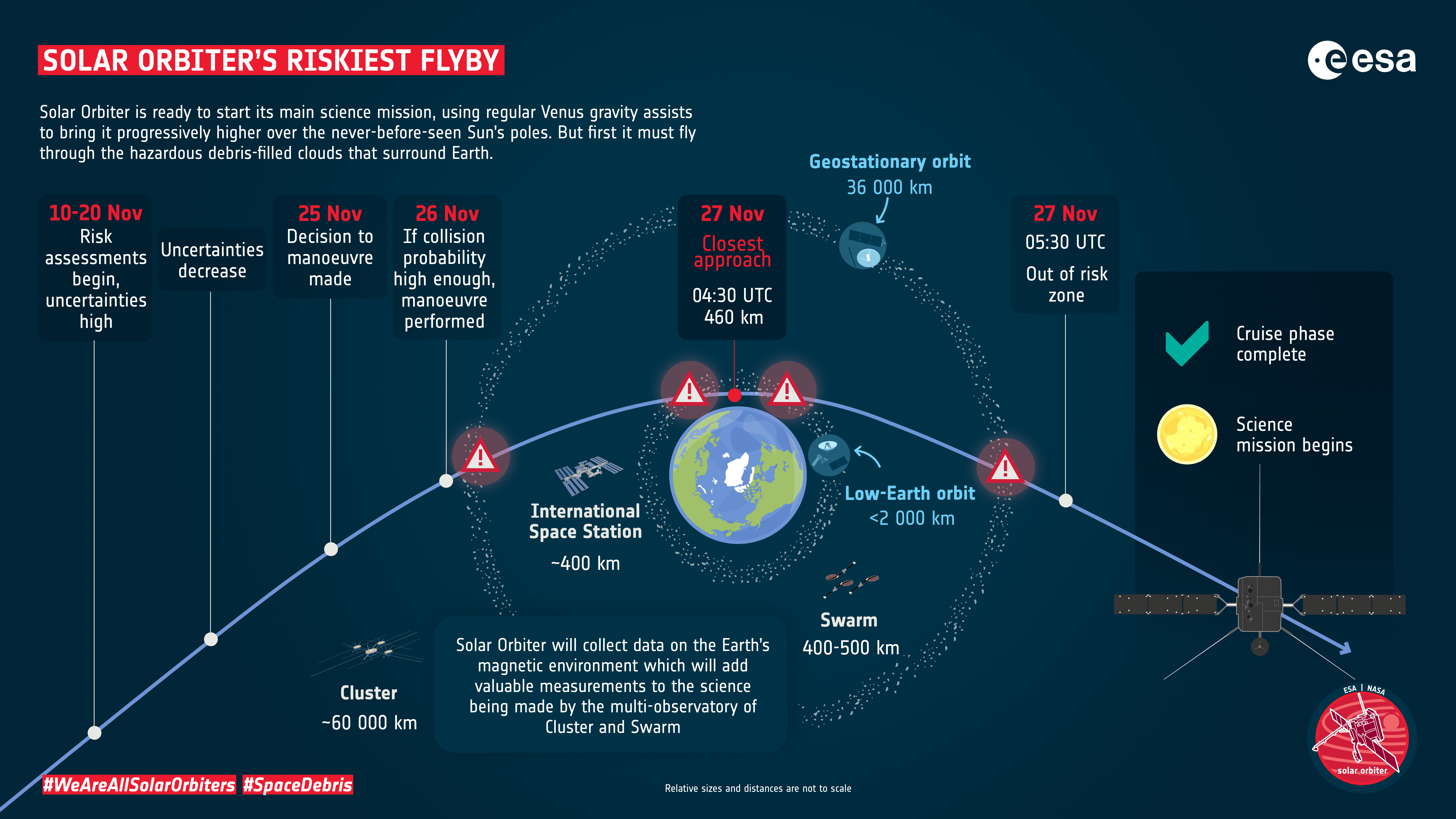Europe's Solar Orbiter will fly by Earth tonight. Here's how to spot it in the night sky.
ESA's Solar Orbiter will be too faint to be seen with the naked eye, but simple binoculars might do.
The European Space Agency's Solar Orbiter spacecraft passes above Earth tonight (Nov. 26) and might be visible from parts of the U.S. and western Africa with either simple binoculars or an amateur telescope.
The spacecraft, which will have to fly through areas of Earth's orbit with the highest concentration of space debris, will get as close as 285 miles (460 kilometers) from Earth's surface during the flyby. This maneuver will use Earth's gravity to nudge the spacecraft and bend its orbit closer to the sun so that it can commence its scientific mission.
The closest pass will be observable from western Africa tonight at about 11:30 pm EST (0430 GMT Nov. 27). Solar Orbiter will then fly above the Canary Islands and across the Atlantic Ocean while it continues to move farther away from Earth's surface. The probe will be visible from the south of the U.S. from midnight to 3 am EST on Saturday (Nov. 27), according to Unistellar, a U.S.-based manufacturer of amateur space telescopes.
Related: Solar Orbiter spacecraft sends postcard from Venus in flyby video

The company has called on amateur astronomers in a statement, asking them to use their telescopes to track Solar Orbiter during the flyby to "help ESA confirm Solar Orbiter's position, determine its brightness, and check the health of the spacecraft".
The spacecraft will be too faint to be visible to the naked eye during the flyby, ESA said on Twitter, and its speed might make tracking it with telescopes challenging. The sun explorer, designed to take the closest-ever images of the star at the center of our solar system, will zoom past the planet at an apparent speed of 0.3 degrees per second. That's equivalent to covering over half of the diameter of the moon in one second, the space agency said on Twitter.
More information about Solar Orbiter's ground track and where to find it in the sky tonight can be found on the Heavens Above website.
Get the Space.com Newsletter
Breaking space news, the latest updates on rocket launches, skywatching events and more!
This Earth flyby will give Solar Orbiter the final kick before its next close approach to the sun, which will take place in March of next year. For the first time, Solar Orbiter will get to its target distance from the sun's surface, about 34 million miles (50 million km). No other spacecraft fitted with a camera has ever flown so close. NASA's Parker Solar Probe dives closer to the sun but the heat it is subjected to is too much for it to carry a sun-facing camera.
During its first close approach to the sun, which took place in June 2020 at a distance of 48 million miles (77 million km), Solar Orbiter discovered miniature solar flares dubbed campfires on the surface of the sun. These campfires might be behind one of the biggest mysteries of the sun's behavior, the extreme heating of its corona.
Follow Tereza Pultarova on Twitter @TerezaPultarova. Follow us on Twitter @Spacedotcom and on Facebook.
Join our Space Forums to keep talking space on the latest missions, night sky and more! And if you have a news tip, correction or comment, let us know at: community@space.com.

Tereza is a London-based science and technology journalist, aspiring fiction writer and amateur gymnast. Originally from Prague, the Czech Republic, she spent the first seven years of her career working as a reporter, script-writer and presenter for various TV programmes of the Czech Public Service Television. She later took a career break to pursue further education and added a Master's in Science from the International Space University, France, to her Bachelor's in Journalism and Master's in Cultural Anthropology from Prague's Charles University. She worked as a reporter at the Engineering and Technology magazine, freelanced for a range of publications including Live Science, Space.com, Professional Engineering, Via Satellite and Space News and served as a maternity cover science editor at the European Space Agency.









